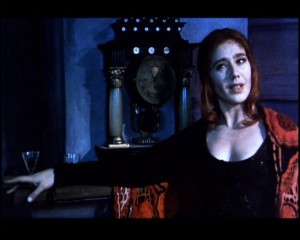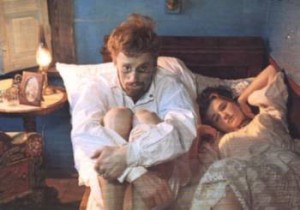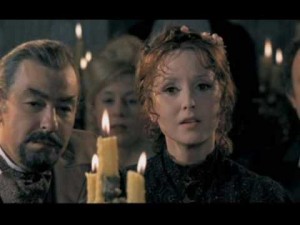From Oui (July 1974). I was able to make my dislike of Blood for Dracula more apparent here than I could when I interviewed Paul Morrissey around the same time in Paris (and for the same magazine), for what proved to be the March 1975 issue. -– J.R.
Blood for Dracula. A Dracula movie by the director
of Flesh, Trash, and Heat (all of which, incidentally,
are currently playing in Paris)? That’s what the credits
say. Blood for Dracula, a grisly number shot in Italy
by Paul Morrissey and coproduced by Andy Warhol,
combines Factory superstar Joe Dallesandro with a
host of authentic European weirdos, including a Count
Dracula (Udo Kier) who puts a lot of greasy stuff in his
hair and sets off for Italy in search of virgin blood.
Unfortunately, the first two damsels he samples aren’t
exactly chaste, leading to a couple of spectacular
vomiting fits. Dallesandro plays a revolutionary peasant
with a a Brooklyn accent who filches most of the available
feminine goodies before the count can get to them, and
then turns hatchet man for the Grand Guignol finale.
Directors Vittorio De Sica and Roman Polanski are also on
hand for comic cameos. –-J.R.
The Wedding. The time is 1900, the place a cottage in
Bronowice — a small village not far from Krakow, the old
capital of Poland, and even closer to the Russian frontier,
where World War I is to break out 14 years later. The
event is a boisterous wedding party following the
marriage of anaristocratic poet to a peasant woman.
Andrzei Wajda’s The Wedding is an adaptation of a
turn-of-the century verse drama by Stanislaus
Wyspianski that has been described as he most
celebrated literary work in Poland. Wajda, known
in the West principally for his bittersweet Polish trilogy
about World War II (A Generation, Kanal, Ashes and
Diamonds) offers on this occasion a colorful pageant
overflowing with traditional folklore. Past, present,
and future intermix with fantasy. and all the characters
whirl about to festive polkas as the party drunkenly
wends its way from dusk to dawn. The Wedding is not,
however, all joy. Anti-Semitism and class conflict form a
central part of the intrigue. Particularly notable are the
dreamlike naturally lighted nocturnal landscapes and
a striking redhead named Maja Komorowska, a Polish
Stella Stevens. –- J.R.





